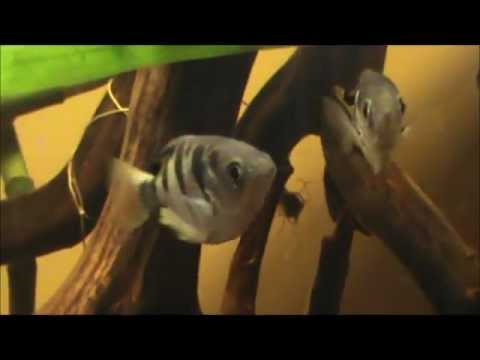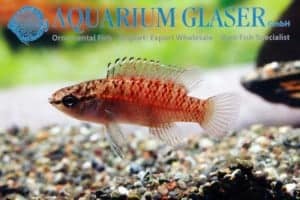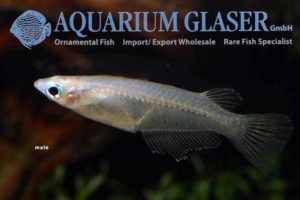Toxotes microlepis – Smallscale Archerfish
Toxotes microlepis was first described by Günther in 1860. The fish belong to the family Toxotidae. The genus name
Appearance, Behavior and Life Expectancy
The Smallscale Archerfish (Toxotes microlepis) has a deep, flattened body with a rounded belly and a relatively short, pointed snout. The back is flat and the belly strongly arched. The eyes are large. The basic color is yellowish to silvery, with dark bands or spots. The fins are generally white to yellowish, sometimes with a dark spot on the dorsal and anal fins. The scales are small, hence the name Smallscale Archerfish. The maximum length is about 15 centimeters.
Gender and age differences: The difference between males and females is very difficult to tell in this species. Juvenile fish are often found in small groups around semi-submerged tree trunks or branches.
Behavior and temperament: Toxotes microlepis is generally a peaceful fish, but may eat smaller co-inhabitants. In an aquarium, it is recommended to keep them in groups of five or more to avoid aggression between conspecifics. They are active and live in middle and upper waters. Although they are not extremely shy, they do require shelter in the form of plants or decorations. They are known for their unique hunting method: accurately shooting insects with a jet of water. This skill can be encouraged in an aquarium by offering food above the surface of the water.
Life expectancy: The expected lifespan of Toxotes microlepis in an aquarium is about 10 years. The lifespan in the wild is not known.
Habitat and Ecology
Toxotes microlepis is found in the wild in India, Sri Lanka, Indonesia, Malaysia, Thailand, Vietnam, Cambodia, Laos, Myanmar and Papua New Guinea. The species is found in both fresh and brackish water, and lives much farther inland than other gunwales, in large rivers and along the banks of flowing and still waters with overhanging vegetation. Examples of rivers where they occur are the Mekong and Chao Phraya.
Their natural habitat is characterized by an abundance of overhanging vegetation along the banks, which serves as shelter and hunting grounds. The water bottom can vary, but is often found with semi-submerged logs or branches.
Diet
In their natural habitat, Toxotes microlepis feed mainly on terrestrial insects, zooplankton, crustaceans and larvae of aquatic insects . They are known for their unique hunting method in which they shoot insects from above the water surface with a jet of water .
In an aquarium, Toxotes microlepis can be fed a varied diet consisting of live foods such as mosquito larvae, small crickets, grasshoppers and other insects. Commercially available frozen foods such as artemia and daphnia can also be offered. It is important to offer the food above the surface of the water to stimulate their natural hunting instinct. A varied diet ensures healthy growth and development. Be careful not to offer prey that is too large, as this can cause digestive problems.
How does Toxotes microlepis shoot a jet of water so accurately?
The Smallscale Archerfish(Toxotes microlepis) generates its water jet through a combination of anatomical adaptations and muscle control. They use a so-called “blowpipe” mechanism for this purpose:
The fish has an elongated, deep groove in the palate (roof of the mouth). The tongue can be pressed against the palate, creating a canal that acts as a kind of “barrel”. This palatinal canal is not formed by a solid bone structure, but by a combination of soft tissues in the palate and tongue. The tongue can be pressed against the palate, closing an elongated, narrow groove into a canal.
By forcefully compressing the gill lids, water is forced from the pharynx into the palatinal canal. The tongue acts as a valve and regulates the flow of water. The muscles surrounding the mouth and pharynx provide precise control over the force and direction of the water jet.
The accuracy of the archer fish is remarkable. The fish takes into account the refraction of light (refraction) at the surface of the water. The fish does not shoot directly to the apparent point where the insect is, but corrects for the deviation of light. This means they have a complex visual system and an ability to calculate the distance and angle of the water jet. The fish also adjusts the force and duration of the water jet depending on the distance to the prey. The fish not only aims the water jet with its mouth, but also uses its entire body to set the angle. The fish remains stationary while shooting, which improves accuracy.
Jumping out of the water
The Smallscale Archerfish(Toxotes microlepis) is a master at hunting insects above the water surface. Not only do they shoot for prey above the water but also jump out of the water to catch their prey. Instead of jumping like a salmon, they use a combination of powerful movements to get out of the water quickly. In doing so, they come out of the water up to about 2.5 times their body length. It is not a single jump, but a three-stage process:
Stage 1: Direction and Preparation: The fish swims just below the surface of the water, focuses its body and eyes on the insect. This is a calm phase, during which the fish accurately determines its position.
Stage 2: Powerful thrust: The fish uses its tail fin for a series of powerful strokes. This is not a simple tail stroke, but a coordinated movement in which the tail fin moves rapidly back and forth, much like a propeller. At the same time, the pectoral, anal and dorsal fins help increase thrust and direction. These fins create strong jets of water that push the fish upward at great speed. Think of a rocket being launched.
Stage 3: Glide: Once the fish leaves the water surface, it stops moving its fins. It now glides through the air, using the speed it built up in Stage 2. This is a ballistic motion, similar to throwing a ball. The fish needs no additional force to get higher; the speed gained in the water brings it to the highest point of its jump.
The combination of these three phases allows the archer fish to leap out of the water and capture its prey with amazing precision and speed. It is a perfectly coordinated action, in which the fish uses its body and fins as a powerful and precise hunting mechanism.
The aquarium
For a group of five or more Toxotes microlepis, an aquarium of at least 150 centimeters is recommended. Larger groups require an even larger aquarium. The decoration should provide shelter, such as floating plants, roots and branches, to make the fish feel safe. A substrate of sand or fine gravel is suitable. The back wall can be decorated with rocks or background decoration. It is important to create sufficient swimming space.
If you want to see the natural hunting behavior of this species, sufficient space above the aquarium is recommended. Note that they can also jump up to 2.5 times their body length out of the water!
The ideal water values for Toxotes microlepis are a pH of 6.5-7.5, a temperature between 23-28°C and medium hardness. It is important to provide clean and well-filtered water.
Toxotes microlepis can be kept well with other similarly sized, peaceful fish that do not serve as food. Suitable co-inhabitants may include certain species of Corydoras, small tetras, and other peaceful bottom dwellers, provided they are large enough not to be eaten. However, it is important to avoid smaller fish, as
Breeding Toxotes microlepis
About the breeding of Toxotes microlepis I have not been able to find any information.
Conclusion
The Smallscale Archerfish(Toxotes microlepis) is a fascinating fish with a unique hunting method, but requires a spacious, well-equipped aquarium and a varied diet. They are not beginner fish, as they require a specific environment and care. Their peaceful nature toward conspecifics depends on group size; a minimum of five specimens is recommended to avoid aggression. The lack of successful breeding in aquaria indicates the complexity of their reproduction.
It is important to emphasize that successfully keeping Toxotes microlepis in an aquarium depends on mimicking their natural habitat, including adequate shelter and a varied diet. Their need for a larger aquarium and the challenges surrounding breeding make them a species for experienced aquarists.
Video
Author
John de Lange
Copyright foto’s
Nonn Panitvong – Siamensis.org








